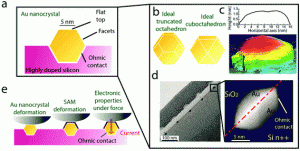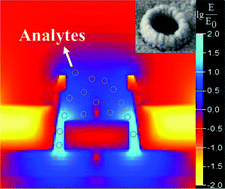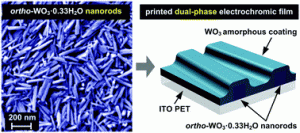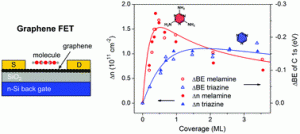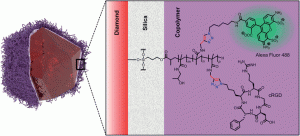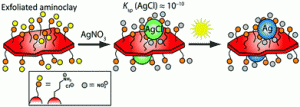Making silica nanoparticle-covered graphene oxide nanohybrids as general building blocks for large-area superhydrophilic coatings
Liang Kou and Chao Gao
Nanoscale, 2011, 3, 519-528
DOI: 10.1039/C0NR00609B
Highly reactive {001} facets of TiO2-based composites: synthesis, formation mechanism and characterization
Wee-Jun Ong, Lling-Lling Tan, Siang-Piao Chai, Siek-Ting Yong and Abdul Rahman Mohamed
Nanoscale, 2014, 6, 1946-2008
DOI: 10.1039/C3NR04655A
Design of advanced porous graphene materials: from graphene nanomesh to 3D architectures
Lili Jiang and Zhuangjun Fan
Nanoscale, 2014, 6, 1922-1945
DOI: 10.1039/C3NR04555B
Photocatalysts with internal electric fields
Li Li, Paul A. Salvador and Gregory S. Rohrer
Nanoscale, 2014, 6, 24-42
DOI: 10.1039/C3NR03998F
Multifunctional superparamagnetic iron oxide nanoparticles: design, synthesis and biomedical photonic applications
Lu Zhang, Wen-Fei Dong and Hong-Bo Sun
Nanoscale, 2013, 5, 7664-7684
DOI: 10.1039/C3NR01616A
Supramolecular self-assemblies as functional nanomaterials
Eric Busseron, Yves Ruff, Emilie Moulin and Nicolas Giuseppone
Nanoscale, 2013, 5, 7098-7140
DOI: 10.1039/C3NR02176A
Focusing on luminescent graphene quantum dots: current status and future perspectives
Lingling Li, Gehui Wu, Guohai Yang, Juan Peng, Jianwei Zhao and Jun-Jie Zhu
Nanoscale, 2013, 5, 4015-4039
DOI: 10.1039/C3NR33849E
Mesoporous silica nanoparticles for bioadsorption, enzyme immobilisation, and delivery carriers
Amirali Popat, Sandy Budi Hartono, Frances Stahr, Jian Liu, Shi Zhang Qiao and Gao Qing (Max) Lu
Nanoscale, 2011, 3, 2801-2818
DOI: 10.1039/C1NR10224A
TEMPO-oxidized cellulose nanofibers
Akira Isogai, Tsuguyuki Saito and Hayaka Fukuzumi
Nanoscale, 2011, 3, 71-85
DOI: 10.1039/C0NR00583E
Photoelectrochemical water oxidation on photoanodes fabricated with hexagonal nanoflower and nanoblock WO3
Nan Wang, Donge Wang, Mingrun Li, Jingying Shi and Can Li
Nanoscale, 2014, 6, 2061-2066
DOI: 10.1039/C3NR05601E
All-solid-state hybrid solar cells based on a new organometal halide perovskite sensitizer and one-dimensional TiO2 nanowire arrays
Jianhang Qiu, Yongcai Qiu, Keyou Yan, Min Zhong, Cheng Mu, He Yan and Shihe Yang
Nanoscale, 2013, 5, 3245-3248
DOI: 10.1039/C3NR00218G
6.5% efficient perovskite quantum-dot-sensitized solar cell
Jeong-Hyeok Im, Chang-Ryul Lee, Jin-Wook Lee, Sang-Won Park and Nam-Gyu Park
Nanoscale, 2011, 3, 4088-4093
DOI: 10.1039/C1NR10867K
Tailor-made directional emission in nanoimprinted plasmonic-based light-emitting devices
G. Lozano, G. Grzela, M. A. Verschuuren, M. Ramezani and J. Gómez Rivas
Nanoscale, 2014, 6, 9223-9229
DOI: 10.1039/C4NR01391C
Improved light absorption and charge transport for perovskite solar cells with rough interfaces by sequential deposition
Lingling Zheng, Yingzhuang Ma, Saisai Chu, Shufeng Wang, Bo Qu, Lixin Xiao, Zhijian Chen, Qihuang Gong, Zhaoxin Wu and Xun Hou
Nanoscale, 2014, 6, 8171-8176
DOI: 10.1039/C4NR01141D
High efficiency electrospun TiO2 nanofiber based hybrid organic–inorganic perovskite solar cell
Sabba Dharani, Hemant Kumar Mulmudi, Natalia Yantara, Pham Thi Thu Trang, Nam Gyu Park, Michael Graetzel, Subodh Mhaisalkar, Nripan Mathews and Pablo P. Boix
Nanoscale, 2014, 6, 1675-1679
DOI: 10.1039/C3NR04857H
Rational morphology control of β-NaYF4:Yb,Er/Tm upconversion nanophosphors using a ligand, an additive, and lanthanide doping
Hyejin Na, Kyoungja Woo, Kipil Lim and Ho Seong Jang
Nanoscale, 2013, 5, 4242-4251
DOI: 10.1039/C3NR00080J
Facile synthesis of water-dispersible Cu2O nanocrystal–reduced graphene oxide hybrid as a promising cancer therapeutic agent
Chengyi Hou, Haocheng Quan, Yourong Duan, Qinghong Zhang, Hongzhi Wang and Yaogang Li
Nanoscale, 2013, 5, 1227-1232
DOI: 10.1039/C2NR32938G
Facile synthesis of lanthanide nanoparticles with paramagnetic, down- and up-conversion properties
Zhengquan Li and Yong Zhang
Nanoscale, 2010, 2, 1240-1243
DOI: 10.1039/C0NR00073F
Why not check out the articles today and let us know your thoughts and comments below?













